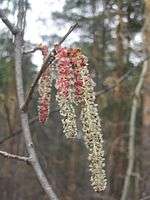Aspen

Aspen is a common name for certain tree species; some, but not all, are classified by botanists in the section Populus, of the poplar genus.[1]
Species
These species are called aspens:
- Populus adenopoda – Chinese Aspen (China, south of P. tremula)
- Populus davidiana – Korean Aspen (Eastern Asia)
- Populus grandidentata – Bigtooth Aspen (eastern North America, south of P. tremuloides)
- Populus sieboldii – Japanese Aspen (Japan)
- Populus tremula – Eurasian Aspen (northern Europe and Asia)
- Populus tremuloides – Quaking Aspen or Trembling Aspen (northern and western North America)
Habitat and longevity
The aspens are all native to cold regions with cool summers, in the north of the Northern Hemisphere, extending south at high altitudes in the mountains. They are all medium-sized deciduous trees reaching 15–30 m (49–98 ft) tall.
All of the aspens typically grow in large clonal colonies, derived from a single seedling, and spread by means of root suckers; new stems in the colony may appear at up to 30–40 m (98–131 ft) from the parent tree. Each individual tree can live for 40–150 years above ground, but the root system of the colony is long-lived. In some cases, this is for thousands of years, sending up new trunks as the older trunks die off above ground. For this reason, it is considered to be an indicator of ancient woodlands. One such colony in Utah, given the nickname of "Pando", is estimated to be 80,000 years old,[2] making it possibly the oldest living colony of aspens. Some aspen colonies become very large with time, spreading about 1 m (3.3 ft) per year, eventually covering many hectares. They are able to survive forest fires, because the roots are below the heat of the fire, with new sprouts growing after the fire burns out.
Aspens do not thrive in the shade, and it is difficult for seedlings to grow in an already mature aspen stand. Fire indirectly benefits aspen trees, since it allows the saplings to flourish in open sunlight in the burned landscape. Lately, aspens have an increased popularity in forestry, mostly because of their fast growth rate and ability to regenerate from sprouts, making the reforestation after harvesting much cheaper, since no planting or sowing is required.
In contrast with many trees, aspen bark is base-rich, meaning aspens are important hosts for bryophytes[3] and act as food plants for the larvae of butterfly (Lepidoptera) species—see List of Lepidoptera that feed on poplars.
Young aspen bark is an important seasonal forage for the European hare and other animals in early spring. Aspen is also a tree of choice of the European beaver.
-
Leaf of Populus grandidentata.
-
Autumn colour of Populus tremula.
-

Male flowers (catkin) of Populus tremula.
-
Aspen grove in fall.
Uses
Aspen wood is white and soft, but fairly strong, and has low flammability. It has a number of uses, notably for making matches and paper where its low flammability makes it safer to use than most other woods. Shredded aspen wood is used for packing and stuffing, sometimes called excelsior (wood wool). It is also a popular animal bedding, since it lacks the phenols associated with pine and juniper, which are thought to cause respiratory system ailments in some animals. Heat-treated aspen is a popular material for the interiors of a sauna. While standing trees sometimes tend to rot from the heart outward, the dry timber weathers very well, becoming silvery-grey and resistant to rotting and warping, and has traditionally been used for rural construction in the northwestern regions of Russia (especially for roofing, in the form of thin slats).
References
- ↑ "technology transfer fact sheet: Populus spp." (PDF). Forest Products Laboratory: R&D USDA. Madison, Wisconsin: United States Department of Agriculture Forest Service. Retrieved 20 September 2010.
- ↑ Quaking Aspen by the Bryce Canyon National Park Service
- ↑ The Biodiversity and Management of Aspen woodlands: Proceedings of a one-day conference held in Kingussie, Scotland, on 25 May 2001
Further reading
- Fox, Mark, Linda E. Tackaberry, Pascal Drouin, Yves Bergeron, Robert L. Bradley, Hughes B. Massicotte, and Han Chen (2013). "Microbial community structure of soils under four productivity classes of aspen forests in Northern British Columbia", Ecoscience 20(3):264-275 DOI:10.2980/20-3-3611
External links
| Wikimedia Commons has media related to Aspen trees in heraldry. |
| Wikisource has the text of the 1911 Encyclopædia Britannica article Aspen. |
- Aspen Information Resource, U.K.
- Quaking Aspen Forests of the Colorado Plateau
- Bioimages: Populus grandidentata bigtooth aspen
- Aspen Research Bibliography
- Aspen Photo Gallery
- Aspen Compounds, Medicinal Benefits and Uses
- Loyola Medicine: Aspen Dosage, Interaction, Warnings and Side Effects
- Steens Aspen Video produced by Oregon Field Guide